Why Are the Subjects of the Parthenonã¢ââ¢s Pediments So Significant for the Study of Art History?
Kingdom of denmark'south oldest grape seeds were locally grown
April 30th, 2017
Archaeologists accept found evidence of homegrown grapes in late Iron Age and Viking Denmark: two charred grape seeds unearthed from a site on the west shore of Lake Tissø, Western Zealand. This is one of the richest sites from the belatedly Germanic Iron Age and Viking Age ever discovered in Denmark. Since the 1990s, excavations have unearthed two aloof residences (one dating to 550–700 A.D., the second to 700–1050 A.D.), pit houses, assembly places, a market and artisan workshop surface area and ritual sites.
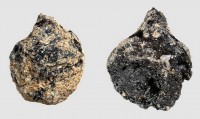
Before this find, the earliest grape seeds found in Kingdom of denmark appointment to the late Center Ages, and historical records from the 13th century support that grapes were grown in Kingdom of denmark during the medieval warm menses. Because this was such an exceptional discovery, the grape seeds were studied in further particular. Each seed was subjected to archaeobotanical assay. One of them, the one from Fugledegård was radiocarbon tested. The C14 result dated it to between 780 and 980 A.D., the Viking Age. The Bulbrogård was not dated because researchers wanted to preserve it for strontium isotope analysis. (The testable cores of the seeds are and so pocket-size information technology wasn't possible to run both tests on each.) The strontium isotope results placed the grape seed squarely in the range characteristic for Denmark, specifically Zealand.

"This is the first discovery and sign of wine production in Denmark, with all that that entails in terms of status and power. We exercise not know how [the grapes] were used – it may have been just to have a pretty bunch of grapes decorating a table, for example – but information technology is reasonable to believe that they made wine," archaeological botanist and museum curator Peter Steen Henriksen of Denmark'south National Museum told Videnskab.dk. […]
"Earlier we only had suspicions, but at present we can meet that they actually had grapes and therefore the resources to produce [wine] themselves. Suddenly it all becomes very real," professor Karin Margarita Frei of the National Museum told Videnskab.dk.
The results of the report have been published in the Danish Periodical of Archaeology and tin can be read hither.
Guennol Stargazer sells for $14,471,500, or does information technology?
April 29th, 2017
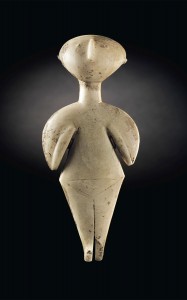
This case, however, is one of only well-nigh 15 complete Stargazers (it has been repaired to reattach the caput to the neck), and it is widely acknowledged as the greatest of them all. She is the tallest at 9 inches and is more long-limbed than her sisters, who tend towards a squatter proportion. The Schuster Stargazer, the last marble Kiliya-type idol to sell at auction, went for a bargain $1,808,000 in 2005. It's not surprising that the Guennol Stargazer equally the preeminent case of the type smashed through that ceiling. While some press outlets reported an estimated sale cost of $3 one thousand thousand, Christie'due south did not accept a pre-sale estimate posted on its website similar it usually does. They made one bachelor by asking merely, which may be an indication that they knew the sky was the limit. As well, estimates commonly rely on comparables also as market determinations, and in terms of quality, design and provenance, the Guennol is in a category of her own.
[youtube=https://youtu.be/tqt4KcF2l_Y&w=430]
The fact that it was part of the Guennol Collection is a testament to its exceptional quality and enhances its already superlative reputation. Edith and Alastair Martin began collecting ancient works of art in 1947 when they were ensourceled into obsession by a few pieces they'd caused. Their approach was not the usual i. They did not focus on a particular time period, geographical area or motif. They simply bought pieces that they and the experts they consulted with idea were exceptionally beautiful examples of their fine art. The Guennol Collection (so named because Guennol is the Welsh word for Martin, and they spent their honeymoon in Wales) was pocket-size — at around a hundred pieces — but and then prestigious that the Metropolitan Museum of Art was thrilled to showroom information technology in its entirety for years. Another figurine from the drove, the powerful and evocative Guennol Lioness, gear up a still-unbroken record for an ancient work of fine art when it sold in 2007 for $57.2 one thousand thousand. (Aww, look at my dinky quondam entry. And the prissy picture I added just now because the original was 1) a terrible thumbnail, and 2) broken.)
There is something of a cliffhanger catastrophe to this episode. The person who made the winning bid may or may not go his or her hands on the Stargazer after all. Culture Minister Nabi Avcı announced to the press on Fri that Turkey has opened proceedings in US courtroom to cease the sale. The Turkish government believes the idol was unearthed in Gallipoli (Kilia, the town where the get-go effigy of the type was found, is on the Gallipoli peninsula) and that it is therefore the legitimate owner.
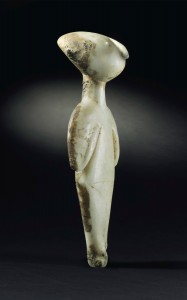
In order to successfully pursue its instance in a U.s.a. courtroom, Turkey needs to have relevant police establishing country ownership of antiquities, which it conspicuously has, and, the big challenge in this example, it has to prove that the disputed antiquity was unearthed within its national boundaries. The court has given Turkey 60 days to provide said proof. Minister Avcı says they have the "necessary scientific reports showing the statue belongs to Turkey" and will submit them within the 2 calendar month deadline.
Meanwhile, Christie's is enjoined from transferring the Guennol Stargazer to the heir-apparent until the instance has been decided.
Quiver of arrows found in Fregerslev Viking grave
April 28th, 2017
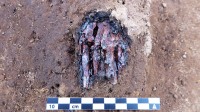
These were probably not weapons of state of war. They were likely used for hunting deer and wild boar. Information technology's even more bear witness of what an elevated position the Fregerslev Viking held in society. Only the aristocracy would have had the opportunity and ways to go hunting, so the bundle of arrows cached with him are symbols of high status.
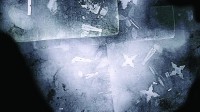
Reaching the bottom of the rider'due south grave is an important milestone. It's only 28 centimeters (11 inches) deep at the deepest signal — it's a miracle that it wasn't destroyed past agronomical activeness — but the sheer amount of corrosion from metals including gilded, bronze and silver visible on the surface of the trench indicates there are however an extraordinary number of expensive grave goods under at that place.
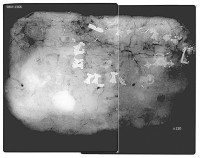
The shiny things aren't the only archaeological treasures in the grave. Archaeologists volition be using the latest and greatest technology to analyze the soil for microscopic remains that volition permit them to identify species of plants that were in one case inside the grave only have rust-covered along with the human and horse remains. They're also going to look for Dna in the soil. German archaeologists have recently had a quantum in this cutting-edge technology, successfully isolating prehistoric Dna from the soil and dirt of caves with nary a bone or tooth in sight.
Bout Ireland'due south Sheela-na-Gigs with Heritage Maps
Apr 27th, 2017

Discussing the launch of this new cultural resource and the St. Patrick connectedness, renowned UCC folklorist Shane Lehane suggests "that perhaps the central to understanding the inherited notion that St Patrick had a married woman, Sheela, is to explore the hugely interesting archaeological manifestation that also bears her name: the Sheela-na-Gig".
"In Ireland, there are over 110 examples of these, oft misunderstood, medieval stone carvings of naked, old women exposing their genitalia. They are frequently positioned in medieval tower-houses, medieval church sites and holy wells. Up to recently these were seen equally figures representing the evils of animalism or as means of averting the 'evil centre'. More convincing reassessments take reinterpreted the Sheela-na-gig, in line with the Cailleach, as belonging to the realm of colloquial folk deities associated with the life-giving powers of nativity and death. Placed with the cycles of both the natural and agricultural year and the human life bicycle, she can be regarded every bit the embodiment of the cycle of fertility that overarches natural, agricultural and human procreation and decease".
Speaking most the launch of the Sheela-na-Gig map, Beatrice Kelly, Heritage Council Head of Policy & Research, stated, "Sheela-na-Gigs are very evocative symbols of the feminine in old Irish culture and their prominent positions in medieval churches and castles attests to the importance of the female in Irish gild. As modern Ireland strives for equality in all aspects of life this map can assist us all to understand the important place women have traditionally held inside our civilization and society."
There are probably more than Sheelas that haven't been officially documented yet. The Heritage Council is hoping to add to the layer with new data and asks that members of the public contact them if they know of any Sheela-na-Gigs that are not still marked on the map.
Every bit the proper noun suggests, Heritage Maps is a collection of culture-related information sets marked on a map of Ireland. You can select different layers to view on the map — shipwrecks, UNESCO Earth Heritage sites, burying grounds, walled towns, museums, protected architectural sites, and hundreds more — and create the female parent of all heritage tours customized to your interests. At that place are more than 150,000 sites pinpointed in all of the layers, and the number increases all the time.
To view the new Sheela-na-Gig dataset, click on the Archæology category in the Layer Listing and check the Sheela-na-Gig box. Yous'll run into the map populate with information points. Click on one of the points and and then on the right arrow subsequently the name for the full information to drop down, including a photo (simply thumbnails, alas).
Massasoit Ousamequin's relics to exist reburied
April 26th, 2017
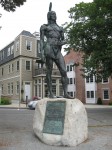
The Pilgrims called him Massasoit as if it were his kickoff name and it has stuck, just in fact it's a hereditary title significant "Bully Leader." His name was Ousamequin. As Slap-up Leader of the Pokanoket Wampanoags, he held the fidelity of numerous chieftains and villages in the Wampanoag Confederation stretching from Narragansett Bay east to Cape Cod, most of modern-solar day southeastern Massachusetts.
In the six years before the Mayflower landed at Plymouth, ii smallpox outbreaks had decimated the Pokanoket, reducing their warrior ranks from a formidable 3,000 to a mere 300. With their enemies the Narragansetts at their doorstep (they controlled the territory west of Narragansett Bay), ready to take advantage of the Pokanoket's war machine weakness, in March of 1621 Ousamequin entered into a treaty of nonaggression and mutual defense with the newly arrived English language colonists. They agreed not to set on each other and to come to each other's aid if either ane were attacked by third parties.
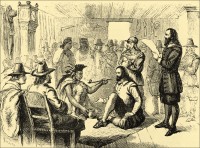
The brotherhood lasted forty years, ending only with Massasoit Ousamequin's death in 1661. English sources acknowledge that the colony would almost certainly have died on the vine in those difficult starting time few years without his invaluable aid and recognized him as a man of unimpeachable integrity, loyalty and generosity. That didn't stop the growing colony from encroaching ever more than on Pokanoket lands, of course, and as the decades passed, the alliance became increasingly strained. Under pressure from all sides, Ousamequin chose to keep the brotherhood together and repeatedly sold the colonists always-larger sections of Pokanoket territory. In 1653, he and his eldest son Wamsutta sold state known as Sowams which included most of the nowadays-twenty-four hour period towns of Warren and Barrington, Rhode Island, and Somerset, Massachusetts, for 35 pounds sterling. The buyers were a who's who of early New England history: Miles Standish, Josiah Winslow, William Bradford, John Winslow, et al.


In 1990, the Native American Graves Protection and Repatriation Deed made information technology federal law that grave appurtenances and human remains held in collections, institutions of learning and museums exist returned to related tribes for reburial co-ordinate to their religious traditions.
Members of the Wampanoag Nation have spent 20 years tracking down the remains and artifacts of Massasoit Ousamequin. Information technology was their "spiritual and cultural obligation," said Ramona Peters, who coordinated the endeavour. […]
Ousamequin's artifacts include a pipe, knife, chaplet and arrowheads.
The Rhode Isle Historical Lodge has repatriated almost 75 items to the advisable tribes since the law's passage, including artifacts vest [sic] to Ousamequin. They were donated every bit relics in the 1800s, only collections aren't assembled in that way today, said Kirsten Hammerstrom, director of collections.
"Grave appurtenances are not something nosotros dig up and take. They belong to the tribe," she said. […]
The Wampanoags take collected hundreds of funerary objects that were removed from the burial ground on the hill and held dozens of burials for their ancestors whose graves were disturbed, Peters said.
"It is an honor and a privilege to be able to do this for our ancestors," she said.
Now it's Massasoit Ousamequin'southward plough.
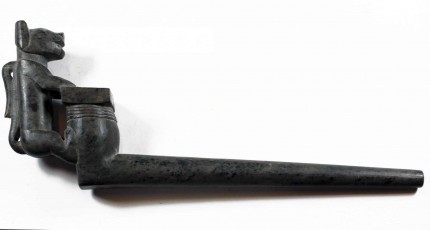
Church mural painted by Jewish "degenerate artist" revealed after 44 years
April 25th, 2017

A Victorian Gothic Revival church built in 1868, St Marker's managed to survive the levelling of the Medieval urban center of Coventry by German language bombing raids in World War II. The neat stained drinking glass window in the west wall was the only casualty. The church couldn't beget to replace the window in the lean state of war and mail service-war years, and then they bricked upwards the hole and the church was left with a very large, very plain wall where the window had one time been.



St Mark'south Church was deconsecrated in 1973 and converted into the outpatients department of the Coventry and Warwickshire Infirmary. For the mural'due south own protection (and maybe to make the infinite a fiddling less obviously a church), the Ascension was bricked over. Fifty-fifty though out of view, it wasn't forgotten.
The Coventry Order said: "Feibusch'south work is now recognised every bit beingness of national importance. In 2011 the Coventry Guild noted that the list particulars for the edifice did non include the mural. We therefore put in a formal request to English Heritage to improve the listing to include the mural and revise other details of the list. This was approved by the Secretary of State for Culture, Leisure and Sport in January 2013."
"In March 2017 it was announced that the building is to be re-opened as a Metropolis Center Resources Church building in September 2017. We are delighted to learn that the future of the building is at present safe and that it is going to be restored."
Hans Feibusch lived a very long life, dying four weeks shy of his 100th birthday in 1998. He not only outlived all of the Nazis who labelled his art degenerate, only likewise all of his young man so-called "degenerate artists." He is buried in Golders Light-green Jewish Cemetery.
Florence Nightingale's Egyptian artifacts to go on display
April 24th, 2017


She began to plan in secret to pursue her vocation. The program was to larn the job by working as a nurse at Salisbury Infirmary for a few months and then come home and display her newly acquired skills to such great advantage caring for the sick and destitute in the local village of West Wellow that any doubts her family might harbor would be instantly dispelled.
She didn't even make it to the first stride. Her mother was so horrified by the thought of Florence working as a nurse in a infirmary that the plan was stillborn. Information technology wasn't the gross aspects of the job that then terrified Mrs. Nightingale. Disease, exposed body parts, gruesome operations, rivers of blood paled in comparison to the sexual shenanigans doctors and nurses were reputed to indulge in on infirmary wards. Nurses were widely seen as piffling more than doctors' paid mistresses.

Florence was passionately opposed to the life expected of her. She felt her calling to the marrow of her being. She wanted to be a "savior" in God'southward name, for her being to have a profound purpose. The Nightingales hoped some travel might distract their adamant daughter, perhaps even inspire her to follow her many intellectual pursuits instead of nursing. In 1847, Florence was sent to Rome with some friends of the family unit. She loved information technology, but as before long every bit she returned to London in 1849, she plant work inspecting hospitals and working at schools for poor children.

Equally for the Egyptian rubbish, y'all may do just what you like with it, keep it or give information technology away. In that location is nothing that reminds me of what I have seen, nothing that savours of my Karnak except the statuary dog, the brick seals which sealed the tombs at Thebes, and the four trivial seals in the light box … yous don't know how hard it is to go anything at Cairo – for I know yous will recollect, and very truly, what I have sent domicile very shabby.

Ashley Cooke, the senior curator of antiquities at the World Museum, is delighted to display her amulets at last. They included 4 to the protective goddess Taweret, particularly cherished by women during childbirth.
"What she brought back is fascinating to us, but I think she expected to be offered ancient treasures and she was very disappointed with what was available," he said. "Ironically we are displaying some of the objects which she did rate and was very pleased at getting hold of – which have turned out, alas, to exist fakes." […]
In a afterward letter she mentioned the well-nigh precious of her seals again: "I possess an antiquity though which I really exercise value, an official seal, of the time of Rameses the Slap-up, my hero, with his cartouche upon it. An undoubted reality. Who volition dare to open letters sealed with the groovy Rameses' own seal?"
Cooke said kindly: "Unfortunately the 4 footling seals are all forgeries but at least they gave her some pleasure and they are quite pretty petty things."

1627 Knight's Tomb in Jamestown conserved
April 23rd, 2017
Since late last year, Jamestown Rediscovery archaeologists have been excavating the Memorial Church, built in 1907 over the foundations of three 17th century churches, the earliest beingness the 1617 timber-frame church in which the Jamestown colonists held the first representative assembly in English North America in 1619. (The second was built in 1640, the terminal in 1680.) The site was excavated in 1901 by the Association for the Preservation of Virginia Antiquities (today known as Preservation Virginia) earlier construction of the Memorial Church. The foundations of the 1617 church were discovered in that dig, merely archaeological priorities and methods were different then, and the APVA team poured concrete between the remains of foundation and wall thinking it would keep them intact. Archaeologists today are removing the physical (no small chore — some sections are as much as five feet deep) to uncover elements in the soil that their predecessors wouldn't have noticed or cared about only that incorporate potentially significant data most the construction of the 1617 church.
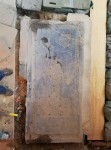
The slab is six by three anxiety in dimension and has inset carvings which in one case held brass plates that identified and glorified the deceased. Y'all tin can meet the commodities holes that once affixed the plates to the stone. In the upper right mitt corner is a shield, whose brass inlay would have been a family crest. Across from it is a scroll, and in the middle is a knight in plate armor standing on a rectangular pedestal which probable contained the full funerary inscription.
Because of the loss of the contumely plates, researchers aren't certain who the knight in question was, but there aren't a ton of candidates. There are in fact just two knights who were buried in the 1617 church: Thomas West, Lord De La Warre, who died on the transatlantic voyage and was buried in Jamestown in 1618, and Sir George Yeardley, who actually managed to land in the Americas alive and well. He was Governor of Virginia during that first General Assembly coming together held in the original church in 1619. He died in 1627 and was cached in the church building.
"When you're studying mortuary practices, when y'all're studying monuments, you never desire to get to the records of the person who died, you want to get to the records of their offspring, of their family unit members who are withal living," said [Assistant Curator with Preservation Virginia Hayden] Bassett. "They're the people who are largely going to be dealing with the logistics of getting a massive stone over here."
Bassett said later searching through the journals of both men's extended families, he thinks Preservation Virginia may have found mentions of the stone past Yeardley's step-grandson Adam Thorowgood II, whose female parent married Yeardley's youngest son, Francis.
"What they mention is that they would like to have a black marble tomb with the crest of Sir George Yeardley and the same inscription equally upon the broken tomb," Bassett said. "We believe that might reference this stone."

The Knight'due south Tomb is no exception. To ensure its long-term health, Jamestown Rediscovery archaeologists knew they'd have to go it out of that cement trap and into the hands of mod conservators who use materials that can exist reversed should they cause problems down the line. On April 10th, conservator Jonathan Appell of of Atlas Preservation, an practiced in the conservation of celebrated awe-inspiring stone memorials and gravestones, began the difficult job of releasing the ledger stone.
The cement around the edges of the gravestone was manus-chiseled abroad. Thankfully, the people who installed it in the flooring of the Memorial Church in the early 20th century did non set it in a bed of Portland cement. Instead it was placed on slate shims over a mortared brick base, so once the cement was removed from the sides and under the edges, the stone could be pried off its base relatively easily. One time the Portland cement was gone, the stone came up in the aforementioned fragments it was first institute in back in 1901. Very carefully and painstakingly, the team moved the stones upwards wooden ramps onto a platform where the detailed conservation will take place.
Y'all tin can meet some of their difficult piece of work explained by Jonathan Appell in this wonderful video on the Jamestown Rediscovery YouTube channel:
[youtube=https://youtu.be/iii316ytxPY&west=430]
That YouTube channel is a jewel, very much worth following and/or bookmarking. They have several videos documenting the electric current digging of the 1907 Memorial Church building.
[youtube=https://youtu.be/Ae1BeL6HOOI&west=430]
[youtube=https://youtu.be/ECWf62JKTQk&due west=430]
[youtube=https://youtu.be/0VdSfqRa9p8&w=430]
[youtube=https://youtu.be/SMacxPi07bQ&westward=430]
Unrelated to the church and its tombs, this video about the discovery and conservation of the most complete set up of jacks of plate (an armoured belong of overlapping plate sewn onto canvas) in the United States is only plainly absurd.
[youtube=https://youtu.be/pwrDUplLO-0&west=430]
2nd parchment manuscript of Declaration of Independence found in UK
April 22nd, 2017
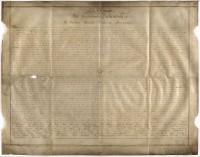
In Baronial 2015, Emily Sneff was working on a database of every known example of the Declaration of Independence for Harvard'south Annunciation Resource Project when she came across a reference to a copy of the Declaration kept in the West Sussex Tape Function. The document was described in the archive's itemize every bit "Manuscript copy, on parchment, of the Declaration in Congress of the thirteen U.s.a.."
She initially suspected it would turn out to be a printed copy of a kind that were widespread in the 19th century because she had encountered such errors — copies mistakenly catalogued as manuscripts even though they were later prints — in other archives. The reference to parchment, however, was unusual and intriguing. She contacted the West Sussex Record Role and they sent her a CD with photographs of the document.

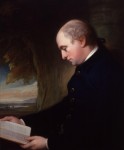
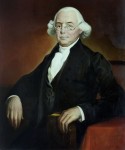
Analysis of the parchment, handwriting and spelling date the Sussex Announcement to the 1780s, a period when these issues were front and center in a U.s. in dire fiscal straits, fraught with conflict about the role of central government versus the states and still governed by the loose Articles of Confederation.
Among the chief political debates of the era, Allen said, was whether the new nation had been founded on the basis of the people's authority or the authority of the states. By reordering the names of the signers, perchance the nigh conspicuous feature of the parchment, the Sussex Announcement comes downward squarely on i side of the argument.
On virtually documents of the era, Allen said, the protocol was for members of each country delegation to sign together, with signatures typically running either downward the page or from left to right, with the names of u.s. labeling each grouping. An exception was made for a small number of specially important documents — including the Declaration, which was signed from right to left, and which omitted the names of united states of america, though the names were nonetheless grouped by state.
"But the Sussex Annunciation scrambles the names so they are no longer grouped by state," Allen said. "It is the only version of the Declaration that does that, with the exception of an engraving from 1836 that derives from it. This is really a symbolic way of maxim nosotros are all one people, or 'i community,' to quote James Wilson."
Read about Sneff's and Allen's use of handwriting and parchment analysis and their examination of spelling errors in the names of the signatories in their showtime published paper on the Sussex Proclamation (pdf). Their second paper (pdf) focuses on James Wilson, the show indicating he deputed the Sussex Declaration and why. They're both fascinating, but I was particularly captivated by the second because I knew cipher virtually James Wilson and he deserved far better from me.
Gold coin hoard found in pianoforte alleged treasure
April 21st, 2017

The school alerted the Finds Liaison Officeholder for the region, Peter Reavill, and he and his colleagues at the Portable Antiquities Scheme examined and catalogued the hoard. Within seven material-wrapped parcels and one suede drawstring pouch, they counted 913 gold sovereigns and half-sovereigns ranging in date from 1847 to 1915, issued in the reigns of Queen Victoria, Edward VII and George Five. The weight of the coins totals more than than 6 kilos (xiii+ pounds) of gilt bullion.

On Apr 20th, John Ellery, senior coroner for Shropshire, held an inquest in Shrewsbury and declared the gilded coins treasure according to the 1996 Treasure Human action, which means they now officially belong to the Crown. The British Museum volition convene a Treasure Valuation Committee to assess the market value of the coins. Local museums will be given the take a chance to larn the hoard for the assessed sum, which will then be divide between finder Martin Backhouse and the piano's owners, the Bishops Castle Customs Higher.
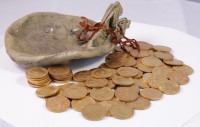
That has non happened in this case, despite the coroner adjourning the inquest twice to give any potential claimants the chance to come forward. Surprising absolutely nobody, many claimants came forward, almost fifty of them, hoping to get their hands on some of that sweetness, sweetness aureate sovereignage, but no evidence was establish to substantiate any of the claims, hence the treasure verdict.
This video from the British Museum'due south YouTube channel tells the story of the Piano Hoard.
[youtube=https://youtu.exist/I2dY_wgVK0I&w=430]
whitforddights1963.blogspot.com
Source: https://www.thehistoryblog.com/page/183
 "In Ireland, there are over 110 examples of these, oft misunderstood, medieval stone carvings of naked, old women exposing their genitalia. They are frequently positioned in medieval tower-houses, medieval church sites and holy wells. Up to recently these were seen equally figures representing the evils of animalism or as means of averting the 'evil centre'. More convincing reassessments take reinterpreted the Sheela-na-gig, in line with the Cailleach, as belonging to the realm of colloquial folk deities associated with the life-giving powers of nativity and death. Placed with the cycles of both the natural and agricultural year and the human life bicycle, she can be regarded every bit the embodiment of the cycle of fertility that overarches natural, agricultural and human procreation and decease".
"In Ireland, there are over 110 examples of these, oft misunderstood, medieval stone carvings of naked, old women exposing their genitalia. They are frequently positioned in medieval tower-houses, medieval church sites and holy wells. Up to recently these were seen equally figures representing the evils of animalism or as means of averting the 'evil centre'. More convincing reassessments take reinterpreted the Sheela-na-gig, in line with the Cailleach, as belonging to the realm of colloquial folk deities associated with the life-giving powers of nativity and death. Placed with the cycles of both the natural and agricultural year and the human life bicycle, she can be regarded every bit the embodiment of the cycle of fertility that overarches natural, agricultural and human procreation and decease".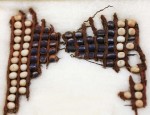 Members of the Wampanoag Nation have spent 20 years tracking down the remains and artifacts of Massasoit Ousamequin. Information technology was their "spiritual and cultural obligation," said Ramona Peters, who coordinated the endeavour. […]
Members of the Wampanoag Nation have spent 20 years tracking down the remains and artifacts of Massasoit Ousamequin. Information technology was their "spiritual and cultural obligation," said Ramona Peters, who coordinated the endeavour. […] The Coventry Order said: "Feibusch'south work is now recognised every bit beingness of national importance. In 2011 the Coventry Guild noted that the list particulars for the edifice did non include the mural. We therefore put in a formal request to English Heritage to improve the listing to include the mural and revise other details of the list. This was approved by the Secretary of State for Culture, Leisure and Sport in January 2013."
The Coventry Order said: "Feibusch'south work is now recognised every bit beingness of national importance. In 2011 the Coventry Guild noted that the list particulars for the edifice did non include the mural. We therefore put in a formal request to English Heritage to improve the listing to include the mural and revise other details of the list. This was approved by the Secretary of State for Culture, Leisure and Sport in January 2013." "What she brought back is fascinating to us, but I think she expected to be offered ancient treasures and she was very disappointed with what was available," he said. "Ironically we are displaying some of the objects which she did rate and was very pleased at getting hold of – which have turned out, alas, to exist fakes." […]
"What she brought back is fascinating to us, but I think she expected to be offered ancient treasures and she was very disappointed with what was available," he said. "Ironically we are displaying some of the objects which she did rate and was very pleased at getting hold of – which have turned out, alas, to exist fakes." […] On virtually documents of the era, Allen said, the protocol was for members of each country delegation to sign together, with signatures typically running either downward the page or from left to right, with the names of u.s. labeling each grouping. An exception was made for a small number of specially important documents — including the Declaration, which was signed from right to left, and which omitted the names of united states of america, though the names were nonetheless grouped by state.
On virtually documents of the era, Allen said, the protocol was for members of each country delegation to sign together, with signatures typically running either downward the page or from left to right, with the names of u.s. labeling each grouping. An exception was made for a small number of specially important documents — including the Declaration, which was signed from right to left, and which omitted the names of united states of america, though the names were nonetheless grouped by state.
0 Response to "Why Are the Subjects of the Parthenonã¢ââ¢s Pediments So Significant for the Study of Art History?"
Post a Comment